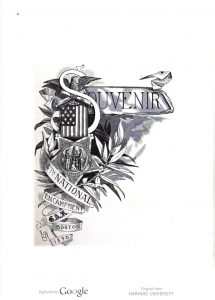Sepia Saturday 437: Fifth in a series on the settlement of my great-great grandfather Arthur T. Bull’s estate. A Union Army veteran of the U.S. Civil War, he was the father of my paternal great grandmother Eva (Bull) Charboneau.
On 13 Aug. 1890, two days before my great-great grandmother Mary E. (Blakeslee) Bull received her Letters of Administration to oversee disposition of her late husband Arthur T. Bull’s estate, she signed a financial bond for $150 — a sum she would forfeit if she fell short on the job.

Two men co-signed as sureties to guarantee the bond — attorney Carey D. Davie (possibly her lawyer) and William H. Crandall (a Union cavalry veteran of the U.S. Civil War who belonged to Arthur’s Grand Army of the Republic lodge after the war).
Carey Davie’s assets were discussed in a previous post — but what did William H. Crandall have to offer as collateral?
Financial backing for a widow
When he generously signed Mary’s administrator bond in Aug. 1890, Willam Crandall provided the following notarized details of his assets. (Handwritten portions are underlined below.)
William Crandall of Salamanca N.Y. the surety named in the foregoing bond being duly sworn, deposes and says that he owns in his own right real estate in the town of Salamanca consisting of house and other building and that it is worth not less than the sum of one thousand dollars, and exclusive of property exempt by law from levy and sale under execution.
And that he owns personal estate in said town, and it is worth not less than the sum of five hundred dollars and that he is worth in good property not less than one thousand dollars over all debts and liabilities which he owes or has incurred and exclusive of property exempt by law from levy and sale under an execution.
In short, William Crandall’s assets — added to Carey Davie’s — were more than sufficient to back widow Mary Bull’s administrator bond and assure a smooth settlement of Arthur’s estate.
Nor is it any surprise that William Crandall stepped forward to do this for the widow of a fellow GAR member.
Union veteran solidarity

In addition to lobbying the federal government, GAR members acted at the state and local level to help widows and dependents where they could.
In some cases, the Grand army established homes for Union veterans and widows as shown in the photo above.
In others, like the case of my widowed great-great grandmother Mary E. (Blakeslee) Bull, members stepped up to help with probate when a veteran died intestate — showing camaraderie and solidarity long after the dusts of battle had settled.
Up next: A brief break for Molly’s Canopy until mid-October. Meanwhile, please visit the blogs of this week’s other Sepia Saturday participants here.
© 2018 Molly Charboneau. All rights reserved.

I have seen estates where the administrators were removed or fined for not fulfilling their administrative responsibilities. They have to report to the court regularly to be reviewed, the ones I looked at.
Interesting. I’m hoping that did not happen to my great-great grandmother. Still have to research the outcome of the estate settlement. However, I suspect if these two men were willing to put collateral on the line, they were pretty confident the would fulfill her duties.
I am so glad to learn more than I previously knew about the GAR as my great grandmother was secretary of the GAR in San Francisco in 1909.
How fascinating! You should do some research on her and maybe a blog post. I’d love to learn more.
The way communities worked to protect veterans, widows, and orphans shows how devastating the Civil War was to America. I have a few band postcards from the soldier’s homes but I didn’t know that there were similar institutions for widows. How many Union veterans lived in Salamanca in the 1890s?
The veterans group for the Southern states, the United Confederate Veterans, had similar issues but I don’t know how successful they were in the politics of the Reconstruction era.
I don’t know the exact stats on Salamanca Union veterans, but there were many of them in the special census — and more than one GAR lodge, too. But you’re right about the war taking a toll that affected so many communities.
I wonder how they decided whether she did an adequate job as administrator.
She would have had to equitably tally the estate, divide it among beneficiaries, and report the outcome to the court. I still have to research the full probate record, so there will be future posts when I have more information.